
Paid advertising has the potential to deliver some of the highest returns on investment (ROI) for businesses.
1. Target the Right Audience
Ad targeting is one of the most important features of paid advertising. For example, whether you’re using Facebook Ads or Google Ads, make sure your campaign is aimed at the right demographic by specifying location, age, interests, and behaviors.
Case Study: Facebook
Facebook famously leverages its data to serve hyper-targeted ads, allowing businesses to market directly to users who show interest in their product categories or brands. This targeted approach helps brands maximize their ad spend.
Lesson Learned: Precision targeting not only improves ROI but also ensures you’re spending money on people who are most likely to convert.
2. Optimize for Conversion
An ad is only as good as its ability to convert. A strong call-to-action (CTA) and landing page optimization can make the difference between a potential lead and a lost opportunity.
Case Study: Shopify
Shopify’s paid ad campaigns are known for having a clear, action-oriented CTA like “Start Your Free Trial.” Every ad points directly to a landing page optimized to convert traffic into trial users, resulting in a seamless customer journey.
Lesson Learned: Optimized landing pages paired with clear CTAs increase your conversion rates from paid ads.
3. A/B Test Your Ads
A/B testing involves running multiple variations of your ads to see which one resonates most with your target audience. Test different headlines, images, CTA buttons, and copy to identify the top performers.
Case Study: Airbnb
Airbnb continuously tests their ad creatives—ranging from imagery to language—to identify what resonates most with potential hosts and travelers. A/B testing helped them improve campaign performance over time.
Lesson Learned: Testing different versions of an ad lets you fine-tune your strategy and ensure every dollar spent is maximized.
4. Monitor and Adjust in Real-Time
Don’t wait for the end of a campaign to make adjustments. Monitoring performance metrics like click-through rate (CTR), bounce rate, and conversion rate in real time allows you to tweak campaigns for optimal performance.
Case Study: Coca-Cola
Coca-Cola runs dynamic ads that can be adjusted in real-time based on performance, allowing them to refresh content and engage users with timely offers. Their ability to shift and refine ads on the fly has contributed to consistently high ROI from their paid campaigns.
Lesson Learned: Real-time adjustments not only maximize your spend by capitalizing on well-performing campaigns, but they also allow you to revise or pause underperforming ones.
Conclusion
Paid ads can elevate your business, driving targeted traffic and enhancing conversion rates. By following best practices demonstrated by Facebook, Shopify, Airbnb, and Coca-Cola, you can not only create high-ROI paid campaigns but also make your business stand out.
💡 Need help launching or optimizing your ad campaigns?
Let’s craft a strategy that gets results.






